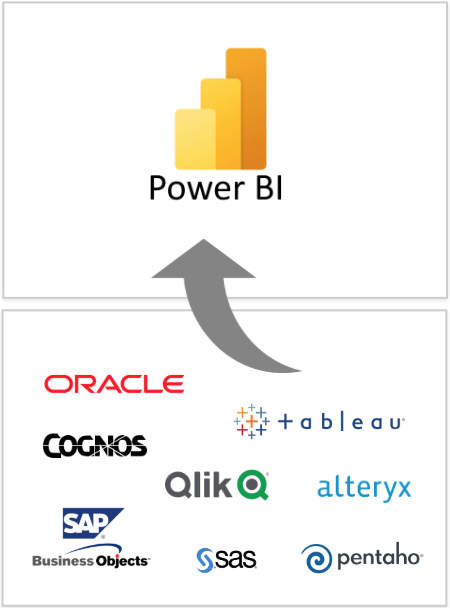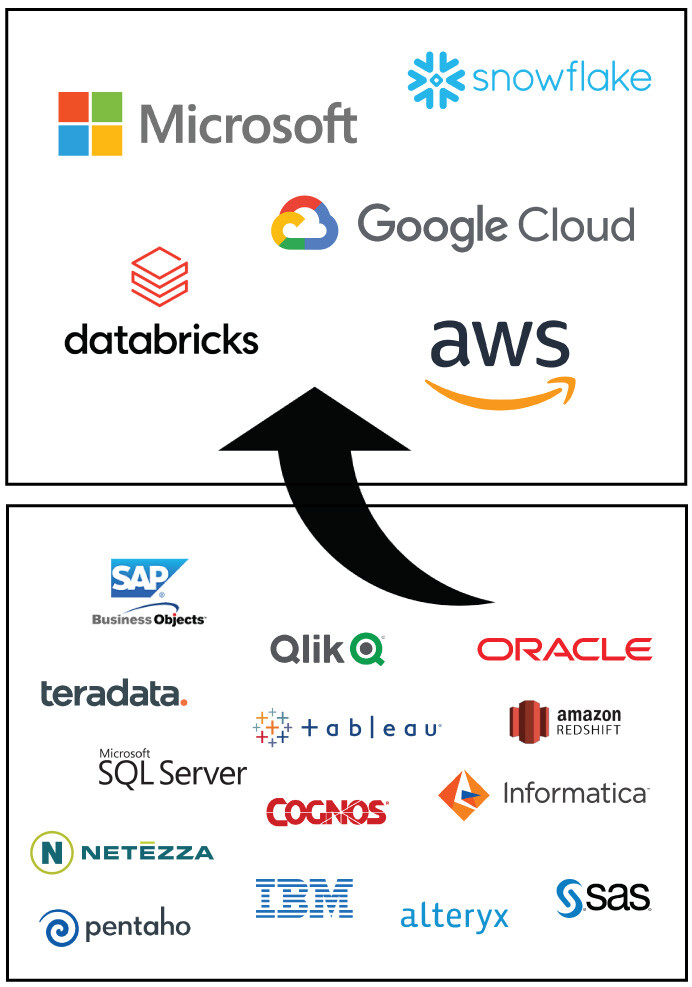SYNEOS HEALTH
"KPI’s BI Modernization Accelerator helped us migrate thousands of dashboards from OBIEE to Power BI in record time. We reduced our reporting backlog, cut support costs, and finally gave users the insights they needed."
By submitting, you consent to KPI Partners processing your information in accordance with our Privacy Policy. We take your privacy seriously; opt out of email updates at any time.
This site is protected by reCAPTCHA and the Google Privacy Policy and Terms of Service apply.
Migrate from any BI tool to any modern BI Platform—Faster, Smarter, and Without the Chaos
Schedule A Consult Learn More
The platform-agnostic DataBridge Suite supports virtually any source-to-target combination—move from legacy BI tools from Oracle, Tableau, or Qlik to Microsoft Power BI.
Our AI-powered accelerators streamline and automate complex steps—saving time, reducing risk, and ensuring business continuity.


Any-Source-to-Any-Target Tool
Our standard BI migration utility can be customized to fit any platform.
Tableau to Power BI Utility
Translates Tableau dashboards and data models into optimized Power BI equivalents.
Qlik to Power BI Utility
Converts Qlik visualizations, scripts, and logic into native Microsoft Power BI components..
Oracle to Power BI Utility
Migrates Oracle BI reports, dashboards, and metadata directly to Power BI.
Pentaho to Power BI Utility
Automates Pentaho content conversion into Power BI-compatible reports and dataflows.
Business Objects to Power BI Utility
Converts SAP BusinessObjects universes and reports into Power BI datasets and visuals.
Analysis Services to Microsoft Fabric
Migrates SSAS models into Direct Lake or semantic models in Microsoft Fabric.
We help you replace aging BI tools with a modern BI platform, such as Power BI and Microsoft Fabric—using proven automation frameworks, generative AI, prebuilt dashboards, and deep platform expertise.

50% faster report migration
Automation cuts manual conversion time in half
30–40% reduction in TCO
Save on licenses, maintenance, and dev hours
Modern BI platform adoption acceleration
Launch with governed content and prebuilt assets
Future-ready BI ecosystem
Ready for AI Copilot, Fabric integration & more
Reduce technical debt by eliminating costly legacy licenses
Cut report migration time in half with automated conversion tools
Adopt GenAI and self-service analytics with a modern, governed Power BI environment
Deliver faster insights to business users across Finance, Operations, HR, and more
KPI DataBridge Suite is designed to help enterprises modernize their data and analytics infrastructure across:


"KPI’s BI Modernization Accelerator helped us migrate thousands of dashboards from OBIEE to Power BI in record time. We reduced our reporting backlog, cut support costs, and finally gave users the insights they needed."
DirectorWe start with a discovery and readiness check
Our experts assess your current BI environment and identify the best-fit migration path.
Accelerator Configuration
Our KPI Team deploys and configures the right pre-built utilities based on your source tools and goals.
Guided Execution
We handle dashboard conversions, governance setup, and enablement with speed and care.
Refine the environment for optimization and handoff
We optimize performance, train teams, and transition ownership—ready for scale.

Lift & Shift From Any BI Tool To A Modern BI Platform

AI-Enhanced Migration To Reduce Cost, Time, Human Error

Pre-Built Analytics Applications For Every Department

Leverage Generative AI to Optimize, Govern, Automate, and Enhance
How do we know if we are a good candidate for BI Modernization?
If you're relying on outdated BI tools, you're likely facing challenges that hinder agility, scalability, and AI readiness. Common signs that your organization is ready for BI modernization include:
If these pain points sound familiar, you're likely a strong candidate for BI Modernization Accelerator and the KPI DataBridge Suite.
What’s the difference between KPI’s BI Modernization Accelerator and traditional migration services?
Traditional consulting often requires starting from scratch. Our BI Modernization Accelerator is a productized solution—with prebuilt migration frameworks, automation utilities, expert services, and governance templates that dramatically reduce cost, time, and risk. You get proven IP and expert delivery in one package.
Which BI platforms do you support?
We support migrations from OBIEE, Tableau, Qlik, SAP BusinessObjects, and IBM Cognos—to modern platforms like Microsoft Power BI, Fabric, and Azure. If you have another platform, contact us to see if it’s supported.
How are your accelerators different from traditional consulting?
Each accelerator is a toolkit of repeatable, prebuilt solutions—not just a custom service. They include automation scripts, generative AI prompts, schemas, migration templates, best practices, and optional managed services to accelerate delivery and reduce cost, complexity, and time-to-value.
Do I need to have Power BI or Microsoft Fabric already deployed?
No. We can assist you whether you're just starting your journey with new tech or looking to optimize and scale an existing deployment. We'll assess your current stack and guide you through the best-fit modernization path.
How long does a typical migration take?
It depends on the size and complexity of your current BI footprint, but our customers typically see migration timelines reduced by 40–50% compared to manual efforts—thanks to automation and our prebuilt accelerators.
Can I license just the tools without the services?
Yes. We offer flexible delivery models. You can license our utilities as standalone solutions, or work with our team for end-to-end execution. Most enterprise clients prefer a blended approach with support for configuration, governance, and adoption.
What makes us different is flexibility. You don’t have to change your tech strategy to fit a limited solution. We bring the expertise, tools, and process to meet you where you are—and help you modernize on your terms. Whether you’re consolidating tools, migrating for cost efficiency, or accelerating AI adoption, KPI Partners has the experience and innovation to make your transformation seamless.
